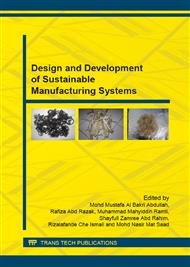p.3
p.9
p.14
p.19
p.24
p.29
p.34
p.39
Properties of Ethylene Propylene Diene Monomer/Recycled Acrylonitrile – Butadiene Rubber Blends (EPDM/rNBR): Effect of the Addition of Bamboo Fillers
Abstract:
Cure characteristics and physical properties of EPDM/rNBR filled bamboo fillers were studied. Results indicated that the addition of bamboo fillers has significant effects on EPDM/rNBR blends. The scorch time, t2 decreased up to 25 phr fillers loading but increased further to 50 phr fillers loading. Cure time, t90 increases as the increase in bamboo fillers in the blends. At a similar blend ratio fine sizes bamboo fillers in EPDM/rNBR (S1: ≤125μm) exhibited higher value of t2 ad t90 compared to EPDM/rNBR (S2: 125-250μm & S3: 250-500μm). The minimum torque, ML also increases with increasing bamboo fillers in the blend. Meanwhile, the maximum torque, MH of the EPDM/rNBR filled bamboo fillers were in contrast. The hardness and degree of crosslink density of the blends increased with the increase in bamboo fillers and reduce percentage of resilience at all blends. The fine sizes of bamboo fillers contributed to the better properties compared to the coarse sizes and medium sizes.
Info:
Periodical:
Pages:
19-23
Citation:
Online since:
November 2015
Keywords:
Price:
Сopyright:
© 2015 Trans Tech Publications Ltd. All Rights Reserved
Share:
Citation:


